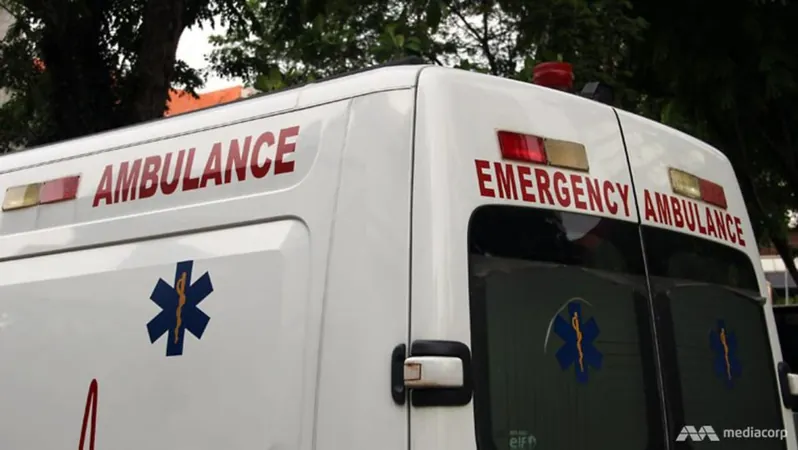
Alarming 22% Surge in Trauma Cases in Singapore: Are We Doing Enough to Prevent It?
2025-04-03
Author: Jia
Introduction
SINGAPORE: In a startling revelation, cases of moderate and severe trauma injuries in Singapore have surged by 22% between 2021 and 2023. This rise in incidents has raised red flags about safety standards and injury prevention in the country.
A Disturbing Case
One of the most disturbing examples is that of Madhivadhana Sathiyamoorthi, who, at just 4 years old, faced a life-threatening ordeal after swallowing 62 magnetic puzzle beads. She was rushed to a polyclinic where an X-ray confirmed the severity of her condition. The magnets had clumped together in her intestines, threatening a dangerous bowel twist that could have been fatal. Madhivadhana underwent emergency surgery at the National University Hospital (NUH), and while the procedure was a success, the now nine-year-old bears a permanent scar as a reminder of her narrow escape.
Her father, Sathiyamoorthi, expressed the overwhelming anxiety experienced during this traumatic time: “At this age, she has to go through abdomen surgeries – it’s unimaginable. I was so worried and stressed.”
Call for Action
Such distressing incidents are prompting urgent action. On April 1, the inaugural National Injury Prevention Conference was convened, co-hosted by NUH’s National University Centre for Trauma and KK Women’s and Children’s Hospital (KKH). The conference aims to spotlight the pressing need for legislative changes and to tackle prevalent causes of traumatic injuries.
Roadmap for Injury Prevention
A comprehensive national roadmap aimed at eradicating common injury causes is in the pipeline, driven by the concerted efforts of NUH and KKH. Critical areas of focus include enhancing enforcement measures and educational outreach about safety practices. Adjunct Assistant Professor Raj Menon, the centre director at NUH, emphasized the importance of educating workplace personnel on managing accidents and calling emergency services promptly. This multifaceted approach seeks to engage not just the government, but the entire community in promoting safer practices.
Emphasizing Safety Measures
Moreover, the conference underscored the responsibility of drivers and passengers to adhere to safety protocols such as buckling up in seatbelts—simple measures that could significantly reduce injuries.
Dr. Ronald Tan from KKH’s department of emergency medicine pointed out that many traumatic pediatric cases are preventable. He urged parents living in high-rise buildings to install window grilles, a proactive step to prevent children from falling. “We want to emphasize that prevention is always better than cure—let's adopt a safety mindset,” stated Dr. Tan, who leads the KKH Injury Prevention Workgroup.
Government's Role
During the conference, Professor Kenneth Mak, director-general of health at the Ministry of Health, emphasized the need for ongoing efforts to safeguard vulnerable populations, including children, in workplace settings, and on the roads. Collaborative efforts among government bodies, such as the Ministries of Health and Manpower and the Road Safety Council, highlight a united front aimed at reducing injury rates.
“To prevent all preventable injuries, we need to share knowledge, embrace best practices, and forge partnerships,” Prof. Mak concluded.
Conclusion
As Singapore grapples with this troubling trend in trauma cases, the question remains: Are we doing enough to protect our citizens, especially the young and vulnerable? With various stakeholders now mobilizing efforts toward prevention, the focus must shift towards fostering a culture of safety to ensure tragic incidents like Madhivadhana's do not recur.


 Brasil (PT)
Brasil (PT)
 Canada (EN)
Canada (EN)
 Chile (ES)
Chile (ES)
 Česko (CS)
Česko (CS)
 대한민국 (KO)
대한민국 (KO)
 España (ES)
España (ES)
 France (FR)
France (FR)
 Hong Kong (EN)
Hong Kong (EN)
 Italia (IT)
Italia (IT)
 日本 (JA)
日本 (JA)
 Magyarország (HU)
Magyarország (HU)
 Norge (NO)
Norge (NO)
 Polska (PL)
Polska (PL)
 Schweiz (DE)
Schweiz (DE)
 Singapore (EN)
Singapore (EN)
 Sverige (SV)
Sverige (SV)
 Suomi (FI)
Suomi (FI)
 Türkiye (TR)
Türkiye (TR)
 الإمارات العربية المتحدة (AR)
الإمارات العربية المتحدة (AR)